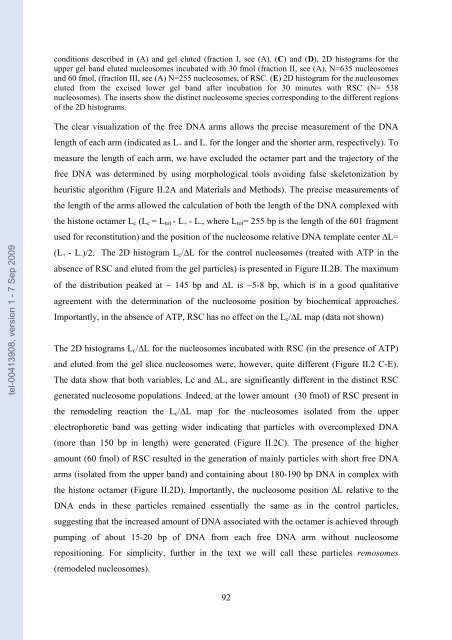Etudes sur le mécanisme de remodelage des nucléosomes par ...
Etudes sur le mécanisme de remodelage des nucléosomes par ...
Etudes sur le mécanisme de remodelage des nucléosomes par ...
You also want an ePaper? Increase the reach of your titles
YUMPU automatically turns print PDFs into web optimized ePapers that Google loves.
tel-00413908, version 1 - 7 Sep 2009<br />
conditions <strong>de</strong>scribed in (A) and gel eluted (fraction I, see (A). (C) and (D), 2D histograms for the<br />
upper gel band eluted nuc<strong>le</strong>osomes incubated with 30 fmol (fraction II, see (A), N=635 nuc<strong>le</strong>osomes<br />
and 60 fmol, (fraction III, see (A) N=255 nuc<strong>le</strong>osomes, of RSC. (E) 2D histogram for the nuc<strong>le</strong>osomes<br />
eluted from the excised lower gel band after incubation for 30 minutes with RSC (N= 538<br />
nuc<strong>le</strong>osomes). The inserts show the distinct nuc<strong>le</strong>osome species corresponding to the different regions<br />
of the 2D histograms.<br />
The c<strong>le</strong>ar visualization of the free DNA arms allows the precise mea<strong>sur</strong>ement of the DNA<br />
<strong>le</strong>ngth of each arm (indicated as L+ and L- for the longer and the shorter arm, respectively). To<br />
mea<strong>sur</strong>e the <strong>le</strong>ngth of each arm, we have exclu<strong>de</strong>d the octamer <strong>par</strong>t and the trajectory of the<br />
free DNA was <strong>de</strong>termined by using morphological tools avoiding false ske<strong>le</strong>tonization by<br />
heuristic algorithm (Figure II.2A and Materials and Methods). The precise mea<strong>sur</strong>ements of<br />
the <strong>le</strong>ngth of the arms allowed the calculation of both the <strong>le</strong>ngth of the DNA comp<strong>le</strong>xed with<br />
the histone octamer Lc (Lc = Ltot - L+ - L-, where Ltot= 255 bp is the <strong>le</strong>ngth of the 601 fragment<br />
used for reconstitution) and the position of the nuc<strong>le</strong>osome relative DNA template center ∆L=<br />
(L+ - L-)/2. The 2D histogram Lc/∆L for the control nuc<strong>le</strong>osomes (treated with ATP in the<br />
absence of RSC and eluted from the gel <strong>par</strong>tic<strong>le</strong>s) is presented in Figure II.2B. The maximum<br />
of the distribution peaked at ∼ 145 bp and ∆L is ∼5-8 bp, which is in a good qualitative<br />
agreement with the <strong>de</strong>termination of the nuc<strong>le</strong>osome position by biochemical approaches.<br />
Importantly, in the absence of ATP, RSC has no effect on the Lc/∆L map (data not shown)<br />
The 2D histograms Lc/∆L for the nuc<strong>le</strong>osomes incubated with RSC (in the presence of ATP)<br />
and eluted from the gel slice nuc<strong>le</strong>osomes were, however, quite different (Figure II.2 C-E).<br />
The data show that both variab<strong>le</strong>s, Lc and ∆L, are significantly different in the distinct RSC<br />
generated nuc<strong>le</strong>osome populations. In<strong>de</strong>ed, at the lower amount (30 fmol) of RSC present in<br />
the remo<strong>de</strong>ling reaction the Lc/∆L map for the nuc<strong>le</strong>osomes isolated from the upper<br />
e<strong>le</strong>ctrophoretic band was getting wi<strong>de</strong>r indicating that <strong>par</strong>tic<strong>le</strong>s with overcomp<strong>le</strong>xed DNA<br />
(more than 150 bp in <strong>le</strong>ngth) were generated (Figure II.2C). The presence of the higher<br />
amount (60 fmol) of RSC resulted in the generation of mainly <strong>par</strong>tic<strong>le</strong>s with short free DNA<br />
arms (isolated from the upper band) and containing about 180-190 bp DNA in comp<strong>le</strong>x with<br />
the histone octamer (Figure II.2D). Importantly, the nuc<strong>le</strong>osome position ∆L relative to the<br />
DNA ends in these <strong>par</strong>tic<strong>le</strong>s remained essentially the same as in the control <strong>par</strong>tic<strong>le</strong>s,<br />
suggesting that the increased amount of DNA associated with the octamer is achieved through<br />
pumping of about 15-20 bp of DNA from each free DNA arm without nuc<strong>le</strong>osome<br />
repositioning. For simplicity, further in the text we will call these <strong>par</strong>tic<strong>le</strong>s remosomes<br />
(remo<strong>de</strong><strong>le</strong>d nuc<strong>le</strong>osomes).<br />
92

















